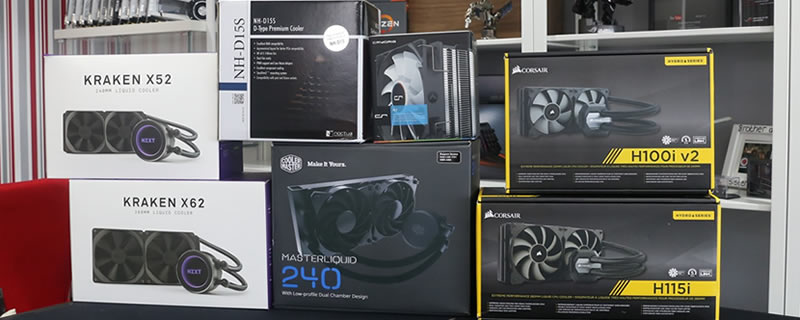AMD Ryzen 5 & 7 CPU Cooler Round Up
Conclusion
At launch, it was difficult to recommend cooling solutions for Ryzen. AMD had not informed consumers about their tCTL offset on their 95W parts which made it unclear what the exact thermal limits of Ryzen were and the lack of AM4 compatible coolers/AM4 upgrade kits made it hard to compare a large range of heatsinks.Â
Now AMD has released a lot of information regarding their tCTL offset “feature” and has updated their Ryzen Master Utility to deliver true temperature readings for their 95W parts (R5 1600X, R7 1700X and R7 1800X), allowing consumers to share information and compare CPU coolers with ease.Â
Ryzen has a thermal limit of 70 degrees, which means that when the CPU gets above that temperature the for more than a few moments the system will shut down in order to prevent damage to your processor. This means that your cooling solution will need to be able to keep your CPU under 70 degrees when under load, as otherwise, your system will shut down when your system is heavily loaded.Â
At stock AMD’s Ryzen CPUs are very easy to cool, with each of the companies stock cooling solutions being very well suited to their designated SKUs, offering low load temperatures and quiet operation, though each of these coolers will quickly become overwhelmed when overclocking.Â
If you plan to use Ryzen at stock frequencies, the companies stock cooler options are more than adequate to keep your system cool and quiet under load, though when trying to overclock your system users will want to invest in aftermarket cooling solutions if they want to achieve high overclocks.Â
We conducted our overclocked testing at a core voltage of 1.4V and a SoC voltage of 1.1V, which is what has allowed us to achieve overclocks of between 3.9-4GHz on almost every Ryzen CPU that we have tested so far with 3200MHz DDR4 memory. This is the kind of overclock that most Ryzen users will be aiming towards, facilitating the need for high-performance aftermarket cooling solutions.Â
Looking at our Cryorig H7, the cheapest CPU cooler that we have tested in this overview, we found that overclocked Ryzen systems simply produced too much heat for this cooling solution at our chosen clock speeds/voltages, with the cooler failing every overclocked test with the exception of our R5 1500X testing. With the 1500X this cooler gave us a load temperature of 66 degrees with its fans at full 12V speeds, only just managing to pass with thermals of 69 degrees when the fan is running at a silent 7V voltage with reduced speeds.Â
When moving up to the 6-core 1600X we found that the affordable Cryorig H7 was simply unable to cope with the CPU’s thermal output in our overclocked testing, showing the need to use higher-end cooling solutions like the dual-tower Noctua NH-D15S air cooler, which ran with a maximum temperature of 63-degrees under load when its fans were running at a silent 7V. Â
With both the R5 1500X and 1600X we found that AIO liquid coolers provided the best results by a large margin, with the Cooler Master MasterLiquid 240 keeping the 1600X at 60 degrees or under when overclocked, leaving plenty of headroom before the CPU reaches Ryzen’s 70-degree thermal limit. Â
Moving up to AMD’s Ryzen 7 series of 8-core CPUs we see that the additional two core over AMD’s Ryzen 5 1600X comes with a significant increase in thermals when overclocked to the same levels with similar voltages. When we overclocked our R7 1800X we found that only the AIO liquid coolers that we tested were able to pass our thermal stress test when using low-speed fans, which is vital for those that do not want a loud system. Â Â
It becomes clear when overclocking Ryzen that users will need to invest in some beefy cooling solutions, especially if you are aiming at a stable 4GHz overclock. At stock, AMD’s Ryzen CPUs are almost too easy to keep cool and quiet, but as you raise the CPU’s voltages you will quickly find that AMD’s stock cooling solutions won’t keep up with your processors raised heat output. Â Â
With AMD’s Ryzen 5 CPUs we would recommend a high-end air cooler or an AIO water cooler if you want to overclock, though the increased core count and heat production of overclocked Ryzen 7 CPU will limit your cooling options to AIO liquid coolers if you want to have a quiet system with low-speed fans.Â
The main problem with Ryzen with regards to thermals is the processors 70-degree thermal limit, with competing Intel products being usable at much higher temperatures. In our thermal testing, we consider an 82-degree CPU temperature as a pass when using a modern Intel i7 7700K, which is why AMD’s new Ryzen lineup seems so much harder to cool.Â
Hopefully, AMD will be able to improve Ryzen’s thermal limits when creating their next generation of products, as more headroom would allow overclockers to create stable systems with lower-end cooling solutions. In simple terms, it is much easier to keep a CPU under 80 degrees than it is to keep the same CPU under 70, though at this time it is impossible to know if AMD will be working to increase Ryzen 2’s temperature limit.Â



